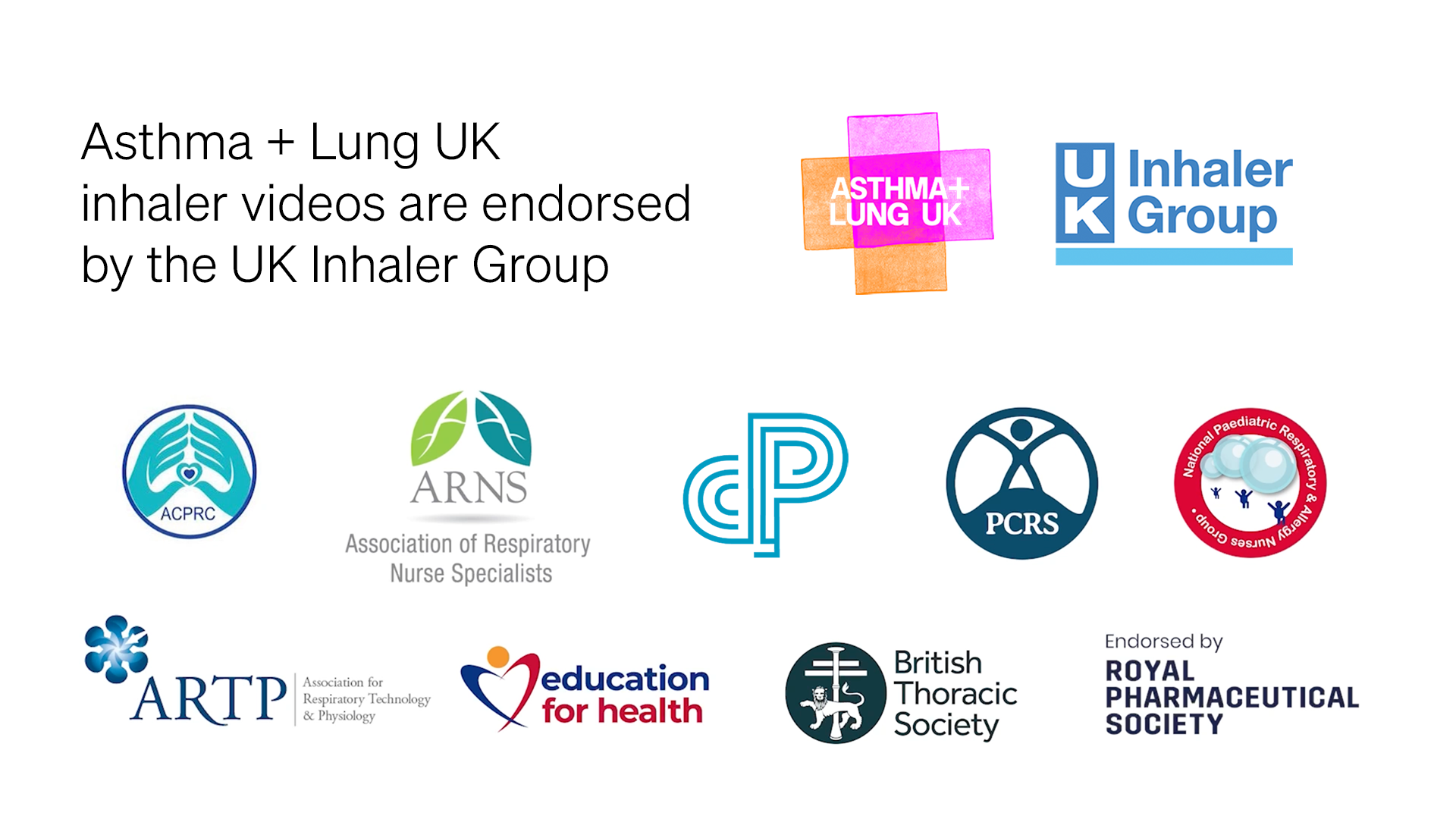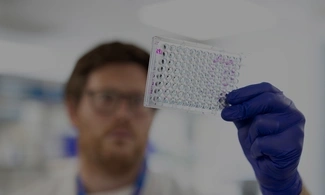
Expert advice for using a spacer with tidal breathing or the 'multiple breath' technique
In this short video, we show you how to use a pressurised metered dose inhaler (pMDI) inhaler with a spacer using tidal breathing or the ‘multiple breath’ technique.
A pMDI inhaler is sometimes called a ‘puffer’.
It’s best to use a spacer with your pMDI inhaler. A spacer helps the medicine get into your lungs and lowers your risk of side effects.
Hello, I’m Pam. I’m a respiratory nurse specialist.
Using a spacer with your inhaler means more of the medicine gets down into your lungs and is a great way to help manage your symptoms.
Getting the technique right is very important. It may take a few tries to feel comfortable using a spacer, but it does get easier with practice.
I’m going to show you how to use an inhaler with a spacer using what’s called ‘tidal breathing’ or the ‘multiple breath’ technique. This is usually recommended if you cannot hold your breath for five seconds after using your inhaler or if you are having an asthma attack.
For most adults and older children, your spacer can be used with a mouthpiece, but a spacer with a mask may be given to you if you cannot put your lips around the mouthpiece to form a tight seal.
If your doctor or nurse has recommended a different technique called the ‘single breath and hold’, watch our other video.
And if you’re helping a baby or child use a spacer, watch our videos on children and spacers.
To use your inhaler with a spacer using the tidal breathing technique:
1. First, hold your inhaler upright and take the cap off.
2. Check there’s nothing inside the mouthpiece.
3. Shake it well [you can leave the inhaler in the spacer while you shake it].
4. If your spacer has a valve, make sure the valve is facing upwards.
5. Put your inhaler into the hole at the back of the spacer.
6. If the mouthpiece of your spacer has a cap, take it off.
7. Sit or stand up straight and slightly tilt your chin up, as it helps the medicine reach your lungs.
The next steps all happen smoothly in one action.
8. Put your lips around the mouthpiece of the spacer to make a tight seal.
9. Press the canister on the inhaler once to release the medicine and breathe in and out slowly and steadily through your mouth into the spacer five times.
10. Remove the inhaler and spacer from your mouth.
11. If you’ve been prescribed a second puff, keep the spacer away from your mouth, wait a minute and shake the inhaler again.
12. Then repeat steps (8 to 10).
Some small volume spacers make a whistling sound if you are breathing in too fast.
If you're using a large volume spacer like this one, you can use the same breathing technique.
With tidal breathing, your spacer should make a clicking sound as the valve opens and closes.
13. When you’ve finished, take the inhaler out of the spacer and replace the caps on both the inhaler and the spacer.
If you’ve used an inhaler that contains steroids, rinse your mouth with water and spit it out to reduce the chance of side effects.
For tips on how to clean your spacer, please visit our website.
Call 999 if:
You’re having an asthma attack or flare-up of your lung condition, and your reliever inhaler is not helping.
Check your inhaler technique
Good inhaler technique helps you breathe the medicine straight into your lungs, where it’s needed. This gives you the best chance of managing your symptoms.
If you’re using your inhaler as prescribed with the right technique, it can help you:
- manage your symptoms without needing to take a higher dose of your medicine
- reduce your risk of having an asthma attack or COPD flare-up. The medical word for this is exacerbation.
- manage your triggers better
- reduce side effects
- make your medicine last longer
- sleep better
- take part in exercise or other activities.
Even if you think your inhaler technique is OK, you may still be able to improve it so that more of the medicine gets deep into your lungs.
It’s especially important to check your inhaler technique if:
- your symptoms are getting worse, or you’ve recently had an asthma attack or COPD flare-up (exacerbation)
- you’re using a new type of inhaler.
You can ask your GP, nurse or pharmacist to check your inhaler technique. Remember that you do not need an appointment to get help from a pharmacist at your local pharmacy.
Tips to help you use your inhaler correctly
Some inhalers need to be shaken well before each use. This includes pressurised metered dose inhalers (pMDIs) and breath-actuated inhalers (BAIs). Four or five times is ideal.
This helps to make sure the medicine and the gas that creates pressure in your inhaler (called the propellant) mix properly.
If you’re not sure whether you need to shake your inhaler, check the Patient Information Leaflet (PIL) that comes with your inhaler or speak to a healthcare professional.
Testing your inhaler usually means checking if you can see medicine coming out without inhaling it. It’s important to check that your inhaler is working properly to make sure you get the right amount of medicine into your lungs.
You should test a pMDI inhaler if you have not used it for a few days or you’re using a new one for the first time. You do not need to test your inhaler before every use.
The Patient Information Leaflet (PIL) that comes with your inhaler might also tell you how often you should test your inhaler. Ask a healthcare professional if you’re not sure or have any questions.
To check how to test your inhaler, check the PIL or ask a healthcare professional. You might test your inhaler by taking the cap off, pointing the mouthpiece away from you, and pressing the canister to release a puff into the air.
Try sitting or standing up straight when using your inhaler. Lifting your chin slightly and holding the inhaler upright can help the medicine reach your lungs.
You might find it helpful to sit or stand in front of a mirror to check your head position.
Place the inhaler in your mouth and make a tight seal around the mouthpiece. A tight seal helps make sure you get the full dose of the medicine.
Before using your inhaler, breathe out through your mouth as much as you can. This creates more space in your lungs so you can take a full breath in through your mouth when you use your inhaler.
Holding your breath after taking your inhaler allows the medicine to settle in your lungs.
If you can, hold your breath for 10 seconds. But only hold your breath for as long as you feel comfortable – the inhaler will still work.
Waiting between each puff also gives the medicine and gas (called a propellant) enough time to mix back together after being shaken.
Some preventer inhalers and combination inhalers, like Maintenance and Reliever Therapy (MART) and anti-inflammatory reliever (AIR), contain steroid medicine.
The steroid medicine can build up on the back of your throat, mouth and tongue and cause side effects including:
- a hoarse voice
- cough
- sore throat
- a mouth infection called oral thrush.
Rinse your mouth with water and spit it out after using your preventer or combination inhaler. This can help to clear any medicine that is stuck in your mouth or throat and help prevent side effects.
Using a spacer with your pMDI inhaler can help deliver the right amount of medicine to your lungs. Using a spacer can also prevent side effects from steroid medicines in preventer or combination inhalers.
There are different ways you can use your spacer. For example, the single breath and hold technique. If you find it difficult to take a deep breath, you can try tidal breathing. This is also called the multiple breath technique.
If you use a pMDI inhaler, breathing in at the right time when you use it helps the medicine get into the small airways deep in your lungs.
Press the canister on your inhaler once and, at the same time, breathe in slowly and steadily. Continue to breathe in until your lungs feel full.
Try to avoid rushing or breathing in your inhaled medicine too quickly.
- If you breathe in too early, you will not have enough time to finish breathing in all the medicine because your lungs will already be full.
- If you breathe in too late, the medicine can stick to your mouth or the back of your throat, instead of getting to your lungs. This is because it takes a very short amount of time for the medicine to be released once the canister is pressed.
Getting into a good medicine routine
You need to take your preventer inhaler every day as prescribed, even if you’re feeling well.
Try these top tips to get into a good medicine routine:
- Set yourself daily reminders on your phone. This can be useful if you’re away from home too. You could also write yourself a note in your diary or in your calendar. You may also want to set a reminder for ordering your prescriptions.
- Keep your inhaler and spacer (if you have one) on your bedside table or near something else you use often, like your daily bag or keys.
- Link taking your inhaler to another daily habit. Research shows you’re more likely to remember to take your medicine every day if you link it to something you already do.
- Ask family or friends to remind you or use an app like the NHS medication reminder service.
This video is not a replacement for professional medical advice. If you’re finding it hard to use your inhaler or you’re worried about your symptoms, please speak with a healthcare professional.
Your GP, nurse or pharmacist can check your inhaler technique. Remember that you do not need an appointment to get help from a pharmacist at your local pharmacy.
Always read the patient information leaflet inside your medicine packet. It tells you more about your medicine, including all the possible side effects and how to store the medicine safely. Speak to your GP, nurse or pharmacist if you have any questions.
Asthma + Lung UK does not endorse or recommend specific products. Read more about how we create our health advice information.


Get support
Call our helpline for support with your condition. Get advice on your medicines, symptoms or travelling with a lung condition, or just call us to say hello.
Find out more











